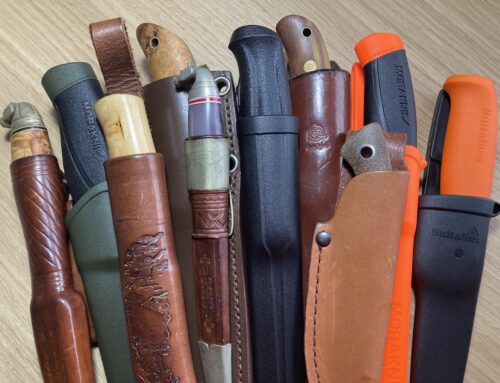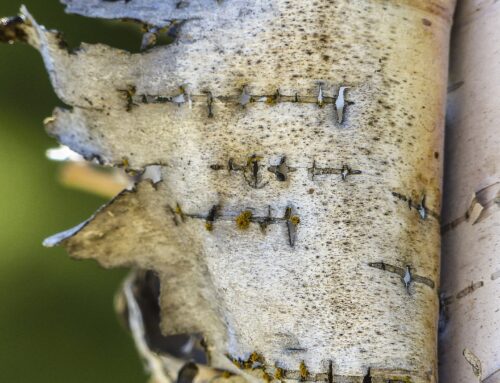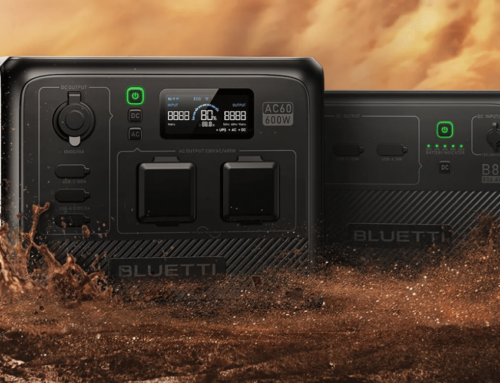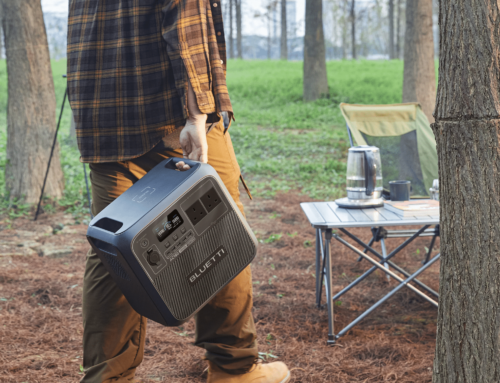Article
By Johnny Walshe
Choosing a knife to use while bushcrafting can be a very personal thing, with opinions held strongly by many as to the perfect knife, here we discuss some of the elements of knives and there make up. When choosing a knife there are many things to consider;
- Functionality
Am I going to be carving, skinning, trying to cut down trees with it? This will dictate the size and shape of the blade.
- Versatility
Is it going to be complimented by outer tools such as an axe or saw or is it to be a dedicated knife for one purpose ie carving?
- Cost
Do I need to or can I afford to spend €300-400 on a hand forged knife or €15 on a frost clipper or something in between?
- Comfort
Does this knife fit comfortable in my hand? Is the weight to my liking? do I feel comfortable using it for the job at hand?
- Suitability
Is the style build quality of the knife applicable to the tasks I want to use it for?
In general terms in Europe people seem to opt for a general purpose knife with a 4 inch fixed blade as there main bushcraft knife in America they often go for a larger blade, possible due to their hunting traditions over there. Choose a fixed blade knife as folding knives have an inherent weakness as the blade is not one piece and at some stage they will break. This could lead to injury or worse if you found yourself in a survival situation and your main tool breaks!
This size of knife is important 4 inches is a nice size blade being comfortable for most tasks, a good size to carve with but yet still large enough to baton for splitting wood. If your knife is complimented by a folding saw and maybe an axe this will accomplish just about every job you would want them to.
The shape of the blade is another important consideration, as a general guide you want to find a blade that is suitable for carving (if it can carve well it can take care of most of the jobs you want it too in the field) and a spear shaped point is ideal for this. Bowie styled knives with the upswept point are not really suitable as they will make a lot of carving jobs hard work and possible unsafe. Pay attention to the various knife shapes and see if you can try them out before buying so you have an idea of how each one behaves.
Blade Hardness
Blade hardness is defined by the Rockwell Scale, 56-58 being the optimum for knife use. The harder the blade the longer it can hold a good edge for, but the more brittle, less flexible and harder to sharpen the blade becomes. Softer blades are easier to sharpen and get a good edge on, but they don’t hold it for as long and don’t have sufficient strength for some applications.
Rockwell Hardness scale
This is a test invented by Stanley P. Rockwell to simply test the hardness of amongst other things metal. It involves measuring the indent made into your sample by the diamond indenter and comparing it to a zero reference measurement the resulting number is your hardness value. There are 30 different scale depending on what substance you are testing, the majority of applications are covered by the Rockwell C and B scales for testing steel, brass, and other metals.
Types of metal
There are many different types of steel used in knife blades each with its own set of pro’s and con’s. Here are the types you may come across.
Carbon Steel
This is a combination of iron and carbon. The more carbon in the steel the harder, stronger and less ductile it becomes, it also makes it harder to weld. Carbon steel will rust and pattern over time, it is a softer type of steel and needs looking after i.e. oiling after use, as it will rust if exposed to air and moisture, working near salt water will exacerbate this problem. It is easier to sharpen than stainless steel which are the two most common blade metals. Here you can see an old carbon steel blade with a flat bevel that has become marked and rusty.

Cold steel
Cold steel is steel worked without heating it in a fire. This is done by hammering to change the molecular structure instead of heating it as is used in other types of steel. It is a time consuming process and one that is not used frequently anymore.
Stainless steel
Stainless steel is an alloy of carbon steel and chromium. A film of chromium oxide forms when it is exposed to air and moisture and prevents it from corroding further. In knife blades it is slightly more brittle than some other steels but will hold an edge well. It can also be harder to sharpen and sometimes harder to strike a fire steel of the back of the blade. Stainless steel is necessary if you’re going to be working with it near salt water.
Damascus
Damascus steel has the reputation of being a very fine steel. Famous from antiquity as having an unsurpassed sharpness and hardness, the Middle Eastern swords being able to cut through the swords of the Europeans and even rock. Modern Damascus today refers to metal with a visible grain pattern. Damascus is a lamination of folded steels, with grinding and polishing the layers are exposed revealing the pattern, whilst still of a very high quality the ancient process that were used have been lost over time.
Laminated
Laminated blades consist of soft metal folded around a hard core to enable a blade to hold its edge for longer while not being overly difficult to sharpen, giving the best of both worlds.
Bevels
The bevel of a knife (or other cutting implements) is the shape of the cross section of the cutting edge of a blade. Different bevels will make a difference to how the knife will perform when in use, some more suited to certain tasks than others, personal preference also playing a key role in what type of knife you choose. The main types of bevel are;
· Single bevel or chisel grind
· Flat bevel
· Convex
· Concave or hollow grind
· Double bevel
Chisel grind
This is where only 1 side of the blade has been ground and the other side remains flat as is the case with a chisel. This style is also used in side axes and in Japanese cooking knives, in these you will have a choice of left or right handed variants. For bushcraft use these are not really suitable as they tend to dig in when carving which makes life difficult.
Flat bevel
The names of the parts are shown in this diagram of a flat bevelled knife. The flat bevelled knife is probably the most common type of grind and is well suited to most tasks being preferred by many as the best shape for general use. It is easily maintained and sharpened requiring no special technique and the cut is even allowing you good control over your work.
Convex
A convex ground blade has a gothic arch shape to it making the cutting part of the blade very strong as it has a lot of support behind the cutting edge. This type of grind is common on axes which need that extra support to stand up to repeated chopping. Often used in Scandinavian knives and being referred to as the Scandinavian grind but this actually refers to a style of flat bevel where the bevel runs part way up the face of the blade. This type of bevel can be more difficult to sharpen, needing a slight rocking motion with the normal technique to maintain the bevel when using a whet stone. Or alternatively can be sharpened by using a computer mouse mat or similar soft pad with 800 or 1200 grit wet and dry sand paper on. This will take the shape of the bevel as you pull the blade across it. I find with good wrist control with this type of bevel can lend itself to a good and accurate carving technique but can be tough on the wrist untill your used to it.

Concave/Hollow ground
Concave or hollow ground blades are extensively used in mass produced knives. It is given its shape by removing the metal from both sides of the blade and can have a very sharp edge, but due to the lack of support behind the cutting edge it can dull quickly, and is not suitable for cutting hard material and is prone to damage. Here you can see a stainless steel blade that is hollow ground blade with a double bevel.

Double Bevel
The double bevel has an extra bevel put on the edge to give it added support whilst cutting allowing it to maintain its sharpness for longer. This is often visible on kitchen knives and cheaper mass produced knives.
Angle of edge
A blade with a very acute angle will slice very well as it has less resistance at the point of cutting, but will also dull quickly as the metal at the tip being so thin wears away quickly. Where as a very shallow angle will not be suitable for cutting, but great for splitting. The ideal angle for cutting/carving wood is between 19.5 – 22 degrees.
Tang
The tang of a blade is the part that enters the handle; this can determine the strength of your knife as without a handle your knife is nearly useless. There are 3 main varieties of tang:
· Half tang
· Full tang
· Needle or rat tail tang
Half tang
Half tang as it implies is where the tang only goes half way into the handle. This is not usually visible without taking the handle apart.
Rat tail tang
Rat tail/needle/nail tang is where the tang is full length in a thin usually round form riveted at the end. Here you can see the end of a rat tail tang in a crook knife.

Full tang
Full tang it the same size as the handle extending the full way back. This gives great strength and support to the blade making it much more suitable for heavier work.


Remenber there are as many different types of knives as there are jobs for them and picking the right knife can make all the difference. So this will help you understand a little more of what makes a knife a knife and hopefully help you to choose one that will last you a lifetime.
Article Source Living Wilderness Bushcraft School[/B]











Leave A Comment
You must be logged in to post a comment.